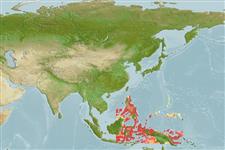Common names from other countries
>
Gobiiformes (Gobies) >
Gobiidae (Gobies) > Gobiinae
Etymology: Trimma: Greek, trimma, -atos = something crushed (Ref. 45335); trioculatum: Name derived from 'tri' for three and 'oculatus' for having eyes; referring to the extra apparent eye formed by the dark ocellated spot in the first dorsal fin..
Environment: milieu / climate zone / depth range / distribution range
Sinh thái học
Biển Cùng sống ở rạn san hô; Mức độ sâu 5 - 71 m (Ref. 102609). Tropical; 20°N - 9°S, 114°E - 154°E
Western Pacific: known with certainty from Indonesia. Non-types collected from Palau, Papua New Guinea and the Philippines.
Bộ gần gũi / Khối lượng (Trọng lượng) / Age
Maturity: Lm ? range ? - ? cm
Max length : 1.9 cm SL con đực/không giới tính; (Ref. 102609); 1.7 cm SL (female)
Short description
Khóa để định loại | Hình thái học | Sinh trắc học
Các tia vây lưng cứng (tổng cộng) : 7; Các vây lưng mềm (tổng cộng) : 8 - 9; Tia cứng vây hậu môn: 1; Tia mềm vây hậu môn: 8. This species is distinguished by the following characters: first dorsal fin with a large (slightly greater than pupil diameter in width) round, black, ocellated spot in between spines 1 and 5; a second, much smaller black or dark red spot just posterior to the spine of the second dorsal fin and above the basal stripe; body yellow with a dark purplish or gray head with two distinct red bars across the cheek; without round spots of any colour on the nape, opercle or cheek; upper pectoral fin base with a small dark (preserved) or white (alive) spot; a narrow bony interorbital (<70% pupil diameter); first dorsal fin without elongated spines; pectoral fin rays 15-16, with the middle 4-8 rays branched; fifth pelvic fin ray with a single dichotomous branch; total gill rakers on the first gill arch 16-17 (Ref. 102609).
Inhabits steep outer reef walls, often present in groups of up to 20 individuals which are loosely aggregated and perched vertically on the substrate at the back of small overhangs and crevices. Non-type specimens collected were also nearly always found on steep outer reef walls (Ref. 102609).
Life cycle and mating behavior
Maturities | Sự tái sinh sản | Spawnings | Egg(s) | Fecundities | Ấu trùng
Winterbottom, R., M.V. Erdmann and N.K.D. Cahyani, 2015. New species of Trimma (Actinopterygii, Gobiidae) from Indonesia, with comments on head papillae nomenclature. Zootaxa 3973(2):201-226. (Ref. 102609)
IUCN Red List Status (Ref. 130435)
CITES (Ref. 128078)
Not Evaluated
Threat to humans
Harmless
Human uses
Các công cụ
Special reports
Download XML
Các nguồn internet
Estimates based on models
Preferred temperature (Ref.
115969): 28 - 29.1, mean 28.6 (based on 68 cells).
Phylogenetic diversity index (Ref.
82804): PD
50 = 0.5000 [Uniqueness, from 0.5 = low to 2.0 = high].
Bayesian length-weight: a=0.00708 (0.00333 - 0.01504), b=3.09 (2.92 - 3.26), in cm Total Length, based on LWR estimates for this (Sub)family-body shape (Ref.
93245).
Thích nghi nhanh (Ref.
120179): Chiêù cao, thời gian nhân đôi của chủng quần tối thiểu là dưới 15 tháng (Preliminary K or Fecundity.).
Fishing Vulnerability (Ref.
59153): Low vulnerability (10 of 100).
